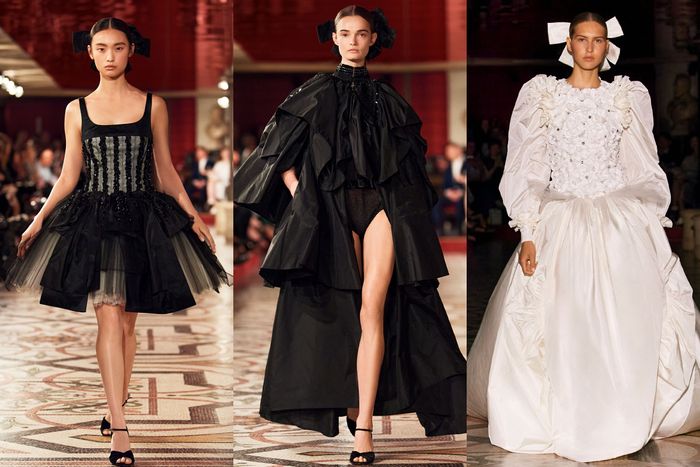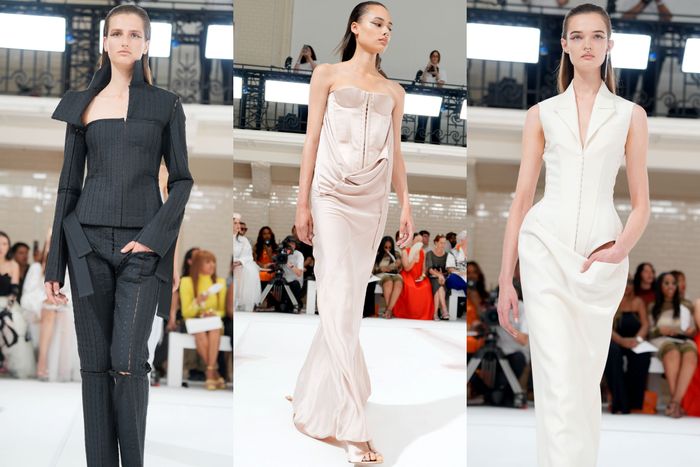Left to right: Jean Paul Gaultier, Balenciaga, Chanel.
Photo-Illustration: by The Cut; Photos: Getty Images; Courtesy of Balenciaga, Chanel
Demna has lately voiced frustration about haute couture. Not the making of a collection but the system of showing it in the same week as other houses. Balenciaga only shows couture once a year, during the summer session, which just ended. Something about the whole ritual feels outdated to him, and I can understand why. You won’t find too many designers questioning the values and assumptions about couture: Why can’t a T-shirt or a denim jacket be regarded as couture if it’s made to the same exacting standards as a satin evening dress? Indeed, the T-shirt might hold more value because it features original artwork.
For his latest collection, Demna asked an artist to paint, in oil, images on a dark navy hoodie and a black oversize T-shirt, both in cotton that was stone-washed and lined with silk scuba satin to support their shape. They pretty much look like metalhead band souvenir garments, except they required about 140 hours of work; they magically hold a semi-rigid form, with extra-wide sleeves that stand away from the body, and the individuals in the images are Balenciaga models, including the artist Eliza Douglas. So these everyday garments have value that’s hard to pinpoint. Demna thought about giving the “band” a name — Threads & Needles — but, as he said, “It became a bit too funny for couture.” He just called it Balenciaga.
Balenciaga
Photo: Courtesy of Balenciaga
Many designers talk about the artistry of couture, and the fact that you can do so much more with tailoring and dressmaking since you’re working by hand. However, relatively few designers experiment with new or atypical materials and construction methods. Thom Browne did this season, using various weights of muslin throughout his collection, along with horsehair canvas. But Demna went further. For a fuzzy electric-blue maxi coat, 168,000 strands of synthetic hair were dyed, embroidered on an organza base, and then given a choppy, careful haircut. The texture of the hair — never mind the idea — certainly makes the design unexpected, and the craftsmanship takes it to another level.
The Balenciaga ateliers also made several column dresses out of upcycled materials, including plastic bags that were melted and then molded into the body’s shape for an elegant white gown. The texture and sheen of the new material resembled rice paper. A black bustier dress was made from hundreds of strips of fake fur that were woven into a classic herringbone pattern. The effect is so subtle that, even at close range, you can’t quite tell what you are seeing.
Balenciaga
Photo: Courtesy of Balenciaga
Cristóbal Balenciaga was a great innovator of fabric and technique. He helped to develop gazar, which feels like a crispy tulle. He was fanatical about sleeves. “For me, the mastery of Cristóbal was using as few seams and darts as possible,” Demna told reporters backstage. “That’s one of the biggest things I admire about his work and the hardest to do.” He began the collection looking at three recurring elements in Balenciaga’s fashion of the 1950s and ’60s: the three-quarter-length sleeve, the effect of a silhouette in profile and hats.
Balenciaga
Photo: Courtesy of Balenciaga
The profile silhouette is probably the most important thing to remember in his latest collection. As bulky and lumpy as some shapes look, with a shirt or a denim jacket inverted and seemingly tied at the waist over wide-leg pants, there is still an impression of a striking Balenciaga silhouette. You also can detect it in the utility coats. There were other subtle links to Cristóbal’s world. Irving Penn famously photographed his wife in Balenciaga’s mantle coat, with its deep folds on the sleeves and shoulders. In the new collection, a leather coat and a parka were similarly scrunched, though not exactly in the same way. The style was Demna’s.
Balenciaga
Photo: Courtesy of Balenciaga
Three years ago, when Balenciaga resumed couture after a break of more than 50 years, the audience that remarkable summer was amazed to see the aesthetic connections between its founder and Demna. In the shows in 2022 and 2023, he continued to present his oversize suiting, some streetwear looks, and evening styles often based on archival pieces. But he said he felt that this approach was becoming “systematic.”
Few designers are more watchful of systematic behavior than Demna. He characterized his latest work as a fusion between Cristóbal’s style and “my own personal vocabulary, which is subcultures.” Another thing I admired about this show, which featured a soundtrack of a woman leading a meditation exercise (very calming), is that it imparted the simple but often neglected belief that wearing clothes should be an experience. Call it style if you prefer. And that’s true for the socialite as well as the metalhead. Demna wrapped up the show, literally, with a cyclonic ball of black nylon gazar that had been created less than an hour before in the backstage with 47 meters of fabric and a stapler.
“I wanted it to be this ephemeral dress,” he explained. “Because nobody really needs couture, to be honest. To me, it’s the experience of wearing clothes. And I wanted to bring it even further, to the notion of performance. This dress only exists for the 15 minutes of an event.”
Chanel
Photo: Courtesy of Chanel
Though the fall couture shows were dominated by nonstop speculation about who would be the next designer at Chanel — which I report in a piece that will be published next week — the collections were generally good. The Chanel studio team staged a competent show at the Opera, where the highlights were a gorgeous deep-purple suit (possibly an embroidery; hard to tell), a black beaded trapeze coat over white pants, and some dramatic opera capes in black. And I can’t imagine how many brides-to-be will covet the floaty, Princess Diana–like wedding dress
Chanel
Photo: Courtesy of Chanel
Giorgio Armani Privé
Photo: Getty Images
Giorgio Armani sailed through his collection, based on the colors and shimmer of pearls. The man will be 90 next month. There was perhaps a pearl too many, but when Armani combines black, cream, ecru, ivory, and a misty gray, he’s hard to beat. The many opening jackets in pearl whites and black, with soft, unmatched trousers, were a school in Armani elegance.
Giorgio Armani Privé
Photo: Getty Images
Gaultier
Photo: Getty Images
Finally, Nicolas Di Felice, the creative director of Courrèges, put on a terrific show on Wednesday evening as Gaultier’s latest guest designer. The concept of inviting a different designer each season has worked well for the house, and Di Felice’s effort ranks among the best. For one thing, he hewed to a fairly narrow style, working with a slim silhouette, a neutral palette, corsetry hooks-and-eyes for both function and embellishment, and column dresses constructed with Gaultier’s telling shape around the hips. And for another, Di Felice let more of his style shine through than have other guest couturiers. He got what he needed from Gaultier and then took off.
Gaultier
Photo: Getty Images











